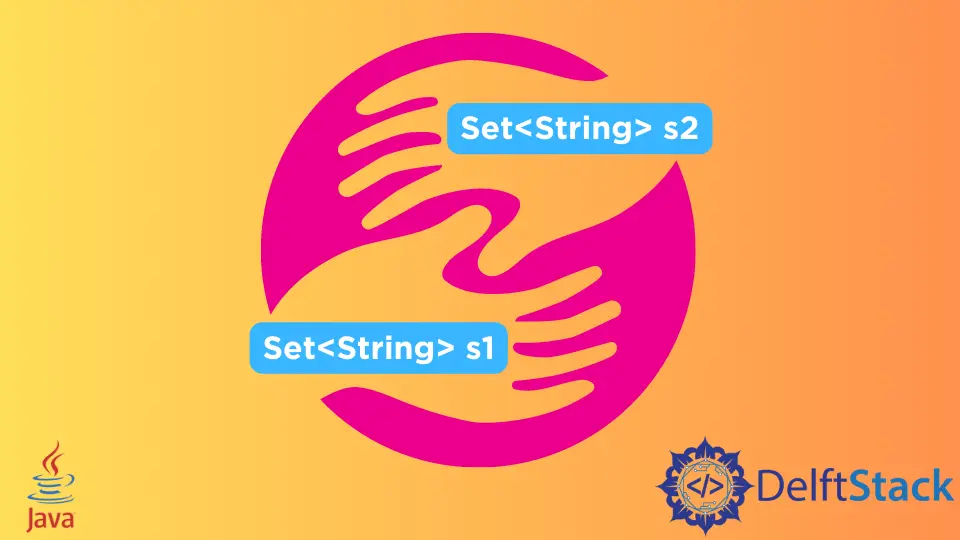兩個 Java 集合的並集和交集

我們將在這個演示中實現兩個程式。第一個示例將使你對確定並集和交集的純 Java 方法有深入的瞭解。
第二個示例將讓你使用 Google 的 Guava API 來操作集合。兩種演算法都成功地確定了結果,同時避免了髒程式碼。
在 Java 中定義並集和交集
- 並集 - 集合 A 或集合 B 中存在的實體數量是 A 和 B 集合的並集。
- 交集 - 兩個陣列 A 和 B 的交集確定屬於 A 和 B 組的元素。
- 集合 - 確定兩個 Java 集的並集/交集的最常用方法。
集合的語法:
// First of all, define your sets as
// Demo set 1
Set<String> s1 = new HashSet<String>();
s1.add("a");
s1.add("b");
s1.add("c");
// set 2
Set<String> s2 = new HashSet<String>();
s2.add("d");
s2.add("e");
s2.add("a");
並集和交集(最簡單的方法):
// union
Set<String> union = new HashSet<>(s1);
union.addAll(s2);
// intersection
Set<String> intersect = new HashSet<String>(s1);
intersect.retainAll(s2);
瞭解用於並集和交集的 Java 方法
在前面的例子中,我們分別定義了兩個陣列集 (s1) 和 (s2)。之後,我們利用兩種方法確定了它們的並集和交集值。
例如,addAll() 表示並集,而 retainAll() 表示交集。
-
addAll()語法:
Set<String> union = new HashSet<>(s1); union.addAll(s2); System.out.println("Result of union:" + union);操作:
假設給定陣列中的值尚不可用。它將它們新增到集合中。
同樣,如果給定的集合也是一個集合,它會將這個集合的值更改為兩個集合的並集。
假設在執行操作時修改了提供的陣列。操作的狀態未定義。
-
retainAll()語法:
Set<String> intersect = new HashSet<String>(s1); intersect.retainAll(s2); System.out.println("Result of intersection:" + intersect);操作:
它僅將給定實體儲存在集合中提供的集合集合中。準確地說,它消除了該集合中不存在於給定陣列中的所有專案。
雖然它還修改/更新這個集合,以便如果給定集合也是一個集合,它的值是兩個組的交集。如果該集合已被修改,則其返回值為
true。
使用純 Java 實現兩個字串集的並集
先前的定義是形成清晰的必要先決條件。現在你必須熟悉 Java 角色中並集和交集的功能、語法和操作行為。
程式碼:
import java.util.*;
public class UnionIntersectionJavaExample {
public static void main(String[] args) {
// set 1
Set<String> s1 = new HashSet<String>();
s1.add("a");
s1.add("b");
s1.add("c");
// set 2
Set<String> s2 = new HashSet<String>();
s2.add("d");
s2.add("e");
s2.add("a");
// union
Set<String> union = new HashSet<>(s1);
union.addAll(s2);
System.out.println("Result of union:" + union);
// intersection
Set<String> intersect = new HashSet<String>(s1);
intersect.retainAll(s2);
System.out.println("Result of intersection:" + intersect);
}
}
輸出:
Result of union:[a, b, c, d, e]
Result of intersection:[a]
Java 中使用 Guava 庫的兩個集合的並集和交集
儘管這取決於你的要求,但並不總是需要將 API 用於像並集和交集這樣簡單的問題陳述。
也就是說,使用這個 Guava 庫還可以讓你瞭解各種簡單的方法。使用 Guava,指定集合比以前更簡單。
Set<String> mysets1 = Sets.newHashSet("This", "is", "set", "one");
同樣,使用方法也更容易。
// For union sets
// Sets.union (reserved function in Guava)
union = Sets.union(mysets1, mysets2);
// For interation
// Sets.intersect (reserved method in Guava)
intersection = Sets.intersection(mysets1, mysets2);
程式碼:(Guava)
import com.google.common.collect.Sets;
import java.util.Set;
public class UnionAndIntersectionGuava {
public static void main(String[] args) {
// Your first Set
Set<String> mysets1 = Sets.newHashSet("This", "is", "set", "one");
// Your Second Set
Set<String> mysets2 = Sets.newHashSet("Here", "is", "set", "two");
// We will use Guava's Sets.union() method
Set<String> union = Sets.union(mysets1, mysets2);
Set<String> intersection = Sets.intersection(mysets1, mysets2);
// Print the output
// System.out.println("Set 1:"+mysets1);
// System.out.println("Set 2:"+ mysets2);
System.out.println("Union:" + union);
// System.out.println("Set 1:"+mysets1);
// System.out.println("Set 2:"+ mysets2);
System.out.println("Intersection:" + intersection);
}
}
}
輸出:
Union:[This, is, set, one, Here, two]
Intersection:[is, set]
你可以從此處下載此 API。之後,將其匯入你的 IDE(當前專案原始檔夾)並設定路徑。
Sarwan Soomro is a freelance software engineer and an expert technical writer who loves writing and coding. He has 5 years of web development and 3 years of professional writing experience, and an MSs in computer science. In addition, he has numerous professional qualifications in the cloud, database, desktop, and online technologies. And has developed multi-technology programming guides for beginners and published many tech articles.
LinkedIn